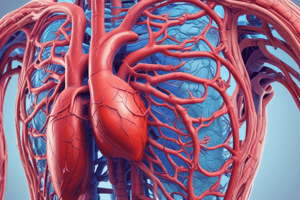Podcast
Questions and Answers
Which of the following best describes the relationship between the circulatory and respiratory systems?
Which of the following best describes the relationship between the circulatory and respiratory systems?
- Both systems independently regulate blood pressure and heart rate.
- The circulatory system removes carbon dioxide from the air, and the respiratory system transports it to the cells.
- The respiratory system delivers oxygen to the blood, which the circulatory system then transports to the body's cells. (correct)
- The circulatory system provides the structure for gas exchange, while the respiratory system transports gases.
During internal respiration, what process occurs?
During internal respiration, what process occurs?
- The exchange of gases between the air and the blood in the lungs.
- The oxygenation of blood within the heart chambers.
- The movement of air in and out of the lungs.
- The exchange of gases between the blood and the body's cells. (correct)
Arteriosclerosis reduces blood flow because:
Arteriosclerosis reduces blood flow because:
- it increases the number of red blood cells, which clog the arteries.
- it causes the blood to become too thick to flow easily.
- it hardens the arteries, narrowing the space for blood to flow. (correct)
- it weakens the heart muscle, reducing its ability to pump blood.
If a blood clot blocks vessels in the brain, it can result in
If a blood clot blocks vessels in the brain, it can result in
What is the primary role of white blood cells in the blood?
What is the primary role of white blood cells in the blood?
In the pathway of air from the nose to the lungs, which of the following sequences is correct?
In the pathway of air from the nose to the lungs, which of the following sequences is correct?
Which component of the blood is primarily responsible for transporting oxygen?
Which component of the blood is primarily responsible for transporting oxygen?
How do the alveoli facilitate gas exchange in the lungs?
How do the alveoli facilitate gas exchange in the lungs?
Flashcards
Circulatory System
Circulatory System
System that moves essential supplies to body cells and removes waste.
Respiratory System
Respiratory System
System that moves oxygen and carbon dioxide between the air and your body.
Cell Respiration
Cell Respiration
Cells use oxygen and food to create energy, carbon dioxide, and water
Stroke
Stroke
Signup and view all the flashcards
Heart Attack
Heart Attack
Signup and view all the flashcards
Arteriosclerosis
Arteriosclerosis
Signup and view all the flashcards
Bronchitis
Bronchitis
Signup and view all the flashcards
Alveoli
Alveoli
Signup and view all the flashcards
Study Notes
Circulatory System
- A group of organs and tissues that transports essential supplies to body cells while removing waste products.
- Also referred to as the cardiovascular system.
Respiratory System
- Moves oxygen and carbon dioxide between the air and the body.
Cell Respiration
- The process where the body's cells are nourished and energized.
- Formula: Oxygen + Food → Carbon dioxide + energy + water
Circulatory System Diseases
- Stroke: A blood clot blocking vessels in the brain.
- Heart Attack: Blockage of blood flow to the heart.
- Arteriosclerosis: Hardening of arteries, reducing blood flow.
- Leukemia: Cancer causing excessive abnormal white blood cells.
Respiration Types
- Internal Respiration: Gas exchange between blood and body cells.
- External Respiration: Oxygen and carbon dioxide exchange between blood and air in the lungs.
Respiratory System Diseases
- Asthma: A common chronic condition causing narrowing or blockage of respiratory system air passages.
- Bronchitis: Infected and swollen bronchi caused by a virus.
- Pneumonia: Lung infection that inflames alveoli, filling them with fluid.
Types of Blood Vessels
- Arteries: Carry oxygenated blood and nutrients from the heart to the body.
- Veins: Carry deoxygenated blood back to the heart.
- Capillaries: Deliver oxygen and nutrients to cells and remove carbon dioxide.
Components of Blood and Their Functions
- Red Blood Cells: Transport oxygen from the lungs to the rest of the body.
- White Blood Cells: Combat bacteria and viruses.
- Plasma: Creates substances to eliminate bacteria/viruses and prevent infections.
- Platelets: Facilitate blood clotting to stop bleeding.
Pathway of Air
- Air enters through the nose/mouth, proceeds to the pharynx, then the larynx, to the trachea, to the bronchial tubes, and finally to the alveoli.
Parts of the Respiratory System and Their Functions
- Larynx: Contains vocal cords.
- Trachea: The windpipe which directs air to the lungs.
- Lungs: Facilitate oxygen transfer to the blood and carbon dioxide removal.
- Bronchi: Main passageways for air entering the lungs.
- Alveoli: Tiny air sacs in the lungs where carbon dioxide is exchanged with oxygen.
- Diaphragm: A dome-shaped muscle separating the chest from the abdomen.
Ways to Care for the Circulatory System
- Decrease stress
- Eat healthily
- Exercise
- Avoid tobacco
Ways to Care for the Respiratory System
- Avoid polluted air
- Don’t use tobacco
- Wash hands and avoid touching nose/mouth
- Engage in physical activity
Impact of Exercise on Circulatory and Respiratory Systems
- Circulatory System: Heartbeat increases, and blood pumps more vigorously.
- Respiratory System: Breathing becomes harder, increasing the workload for the lungs.
Studying That Suits You
Use AI to generate personalized quizzes and flashcards to suit your learning preferences.




